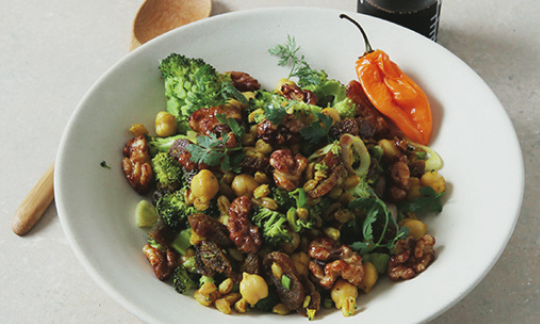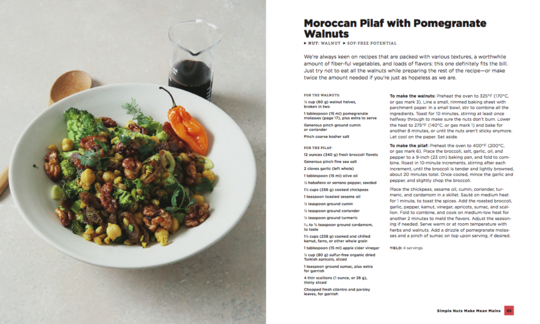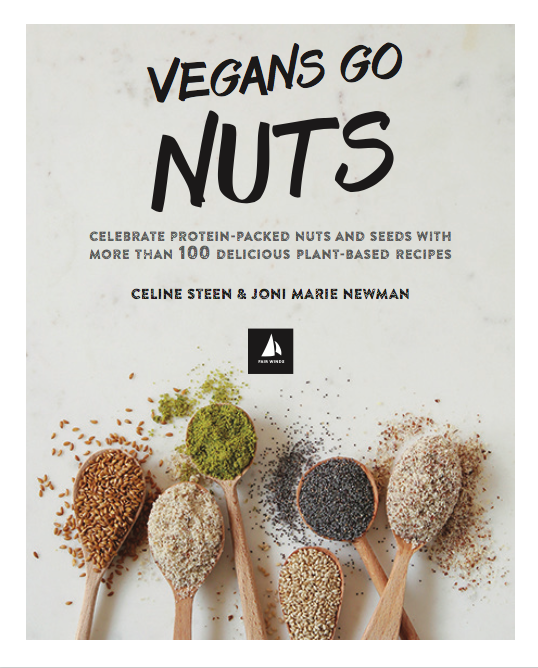Moroccan Pilaf with Pomegranate, Walnuts, and Chickpeas
vegan
Ingredients (for servings, )
Equipment
- baking pan (springform pan)
- skillet (frying pan)
- stove
- oven
- baking sheet (cookie sheet)
Type of preparation
- bake
- chop or grind
- sauté
- dry roast
Preparation
To make the walnuts
Preheat the oven to 325 °F (170 °C or gas mark 3). Line a small, rimmed baking sheet with parchment paper. In a small bowl, stir to combine all the ingredients. Toast for 10 minutes, stirring at least once halfway through to make sure the nuts don’t burn.In the original recipe, the authors use pomegranate molasses instead of pomegranate syrup (here and in Step 8).
Lower the heat to 275 °F (140 °C or gas mark 1) and bake for another 8 minutes, or until the nuts aren’t sticky anymore. Let cool on the paper. Set aside.
To make the pilaf
Preheat the oven to 400 °F (200 °C or gas mark 6). Wash the broccoli and cut into florets. Deseed the chili pepper.The authors suggests using habañero or serrano peppers.
Place the broccoli, salt, garlic, oil, and pepper in a 9-inch (23 cm) baking pan, and fold to combine. Roast in 10-minute increments, stirring after each increment, until the broccoli is tender and lightly browned, about 20 minutes total.
Once cooled, mince the garlic and pepper, and slightly chop the broccoli.
Finely slice the apricots and scallions and set to the side. Place the chickpeas, sesame oil, cumin, coriander, turmeric, and cardamom (all spices ground) in a skillet. Sauté on medium heat for 1 minute, to toast the spices.
Add the roasted broccoli, garlic, chili pepper, kamut, vinegar, sliced apricots, sumac, and thinly sliced scallions. Fold to combine, and cook on medium-low heat for another 2 minutes to meld the flavors. Adjust the seasoning if needed.
Serving
Serve warm or at room temperature with herbs and walnuts. Add a drizzle of pomegranate syrup and a pinch of sumac on top upon serving, if desired.The authors suggest using chopped fresh cilantro and parsley leaves for garnish.
|
Nutritional Information per person
Convert per 100g
|
2000 kcal | |
|---|---|---|
| Energy | 404 kcal | 20.2% |
| Fat/Lipids | 17 g | 23.7% |
| Saturated Fats | 1.8 g | 8.9% |
| Carbohydrates (inc.dietary fiber) | 58 g | 21.6% |
| Sugars | 16 g | 18.3% |
| Fiber | 15 g | 58.7% |
| Protein/Albumin | 15 g | 30.4% |
| Cooking Salt (Na:121.5 mg) | 309 mg | 12.9% |
| Essential micronutrients with the highest proportions | per person | 2000 kcal | |
|---|---|---|---|
| Vit | Vitamin K | 106 µg | 141.0% |
| Min | Manganese, Mn | 2.1 mg | 106.0% |
| Vit | Vitamin C (ascorbic acid) | 80 mg | 100.0% |
| Fat | Alpha-Linolenic acid; ALA; 18:3 omega-3 | 1.4 g | 72.0% |
| Fat | Linoleic acid; LA; 18:2 omega-6 | 7.0 g | 70.0% |
| Min | Copper, Cu | 0.67 mg | 67.0% |
| Vit | Vitamin B9, B11 (Folate, as the active form of folic acid) | 124 µg | 62.0% |
| Prot | Tryptophan (Trp, W) | 0.15 g | 59.0% |
| Prot | Threonine (Thr, T, irreversibly transaminated) | 0.53 g | 57.0% |
| Prot | Isoleucine (Ile, I) | 0.66 g | 53.0% |
Detailed Nutritional Information per Person for this Recipe
The majority of the nutritional information comes from the USDA (US Department of Agriculture). This means that the information for natural products is often incomplete or only given within broader categories, whereas in most cases products made from these have more complete information displayed.
If we take flaxseed, for example, the important essential amino acid ALA (omega-3) is only included in an overarching category whereas for flaxseed oil ALA is listed specifically. In time, we will be able to change this, but it will require a lot of work. An “i” appears behind ingredients that have been adjusted and an explanation appears when you hover over this symbol.
For Erb Muesli, the original calculations resulted in 48 % of the daily requirement of ALA — but with the correction, we see that the muesli actually covers >100 % of the necessary recommendation for the omega-3 fatty acid ALA. Our goal is to eventually be able to compare the nutritional value of our recipes with those that are used in conventional western lifestyles.
| Essential fatty acids | per person | 2000 kcal |
|---|---|---|
| Alpha-Linolenic acid; ALA; 18:3 omega-3 | 1.4 g | 72.0% |
| Linoleic acid; LA; 18:2 omega-6 | 7.0 g | 70.0% |
| Essential amino acids | per person | 2000 kcal |
|---|---|---|
| Tryptophan (Trp, W) | 0.15 g | 59.0% |
| Threonine (Thr, T, irreversibly transaminated) | 0.53 g | 57.0% |
| Isoleucine (Ile, I) | 0.66 g | 53.0% |
| Phenylalanine (Phe, F) | 0.71 g | 46.0% |
| Leucine (Leu, L) | 1.0 g | 43.0% |
| Valin (Val, V) | 0.70 g | 43.0% |
| Lysine (Lys, K, irreversibly transaminated) | 0.72 g | 38.0% |
| Methionine (Met, M) | 0.20 g | 22.0% |
| Vitamins | per person | 2000 kcal |
|---|---|---|
| Vitamin K | 106 µg | 141.0% |
| Vitamin C (ascorbic acid) | 80 mg | 100.0% |
| Vitamin B9, B11 (Folate, as the active form of folic acid) | 124 µg | 62.0% |
| Vitamin B6 (pyridoxine) | 0.45 mg | 32.0% |
| Vitamin B1 (Thiamine) | 0.28 mg | 26.0% |
| Vitamin E, as a-TEs | 3.1 mg | 26.0% |
| Vitamin B3 (Niacin) | 4.0 mg | 25.0% |
| Vitamin B7 (Biotin, ex vitamin H) | 9.2 µg | 18.0% |
| Vitamin B2 (Riboflavin) | 0.21 mg | 15.0% |
| Vitamin B5 (Pantothenic acid) | 0.92 mg | 15.0% |
| Vitamin A, as RAE | 77 µg | 10.0% |
| Essential macroelements (macronutrients) | per person | 2000 kcal |
|---|---|---|
| Phosphorus, P | 335 mg | 48.0% |
| Potassium, K | 903 mg | 45.0% |
| Magnesium, Mg | 123 mg | 33.0% |
| Calcium, Ca | 117 mg | 15.0% |
| Sodium, Na | 122 mg | 15.0% |
| Essential trace elements (micronutrients) | per person | 2000 kcal |
|---|---|---|
| Manganese, Mn | 2.1 mg | 106.0% |
| Copper, Cu | 0.67 mg | 67.0% |
| Selenium, Se | 24 µg | 44.0% |
| Iron, Fe | 5.0 mg | 36.0% |
| Zinc, Zn | 3.1 mg | 31.0% |
| Iod, I (Jod, J) | 20 µg | 13.0% |
| Fluorine, F | 11 µg | < 0.1% |
'Vegans Go Nuts - celebrate protein packed nuts and seeds with more than 100 delicious plant-based recipes’ shows the diversity of nuts and seeds.
ConclusionIn Vegans Go Nuts, Celine Steen and Joni Marie Newman show the many ways in which nuts and seeds can be used. Unfortunately, the authors do not go into the major differences in the health values of the individual nuts. Also, despite the many nuts and seeds, additional oils are often used. However, by consciously using nuts with health benefits and making slight changes, you can prepare new and healthy vegan recipes with the help of the recipes listed.
|
Critical book reviews |
General impressionIn Vegans Go Nuts - celebrate protein packed nuts and seeds with more than 100 delicious plant-based recipes, Celine Steen and Joni Marie Newman have put together a large selection of nut and seed-based vegan recipes. The authors start by introducing a wide variety of nuts and seeds. They focus in particular on the differences in flavours and textures after processing the nuts and seeds and highlight the health benefits of the individual ingredients. However, this means that the disadvantages take a back seat. It would be desirable to compare the nuts in terms of their health value, in particular the ratio of omega-6 to omega-3 fatty acids, which should not exceed a ratio of 5:1. This would make it easier to select the appropriate nuts in the dishes - as the type of nut is often left to the reader's discretion. The authors emphasise that nuts and seeds are particularly beneficial in raw or dry roasted and unsalted form. The statement that all nuts are healthy, regardless of the type, is not entirely correct, especially in view of the very different ratios of essential fatty acids. You can find out more about this under the following link: Vegans often eat unhealthily.
The recipes are clearly presented and are labelled gluten-free, soy-free, oil-free and quick and easy. The additional tips (recipe notes) are a helpful addition. Unfortunately, only some of the recipes are illustrated. An additional indication of preparation times would be desirable with regard to planning. The use of many different nuts and seeds and the frequent use of wholegrains are successful from a health perspective. Unfortunately, despite the many nuts and seeds, added oils are still frequently used, but rarely a lot. Sweeteners of various kinds are also often present and, especially in desserts, in large quantities. It would be preferable to reduce these or switch to fruit sweeteners. Tinned food is also found in around one in ten dishes. A complete avoidance of processed products would also be preferable here. It is pleasing to see that many home-made ingredients such as nut butter, nut milk and similar are used, which are listed in the basics.
Vegans Go Nuts by Celine Steen and Joni Marie Newman is a vegan recipe book that demonstrates the versatility of nuts and seeds through its varied recipes.
By making slight changes and consciously using particularly healthy nuts, you can conjure up not only delicious but also healthy vegan dishes from many of the recipes listed. Vegans Go Nuts by Celine Steen and Joni Marie Newman is currently only available in English. You can buy it from Quarto Knows and Amazon.
About the authorsCeline Steen, who lives in California, switched to a vegan diet in 2005 for ethical reasons. She is the co-author of several cookery books and founder of the award-winning blog Have Cake, Will Travel.
Joni Marie Newman is the founder of justthefood.com and author of 10 cookery books. She is well known in the vegan community and is a frequent speaker at vegan conferences and other events.
Contents of the bookVegans Go Nuts is divided into 6 chapters:
- In the Kitchen with Nuts and Seeds
- Nuts and Seeds Basics
- Cheers to Nutritious Mornings
- Simple Nuts Make Mean Mains
- Substantial Soups, Sides, and Salads
- Ending Things on a Sweet Nut
In the kitchen with nuts and seeds: Here you will find a glossary of nuts and seeds, tips on storing them and a glossary of some more unusual ingredients.
Recipes
Nuts and Seeds Basics: The recipes range from simple roasted nuts to nut butters, nut milks, nut flours, spreads, dressings, dips and nut cheeses. Examples include the Almond-Milk Cream Cheese Spread and the Citrusy Cashew Baba Ghanoush.
Cheers to Nutritous Mornings:Here you will find sweet or savoury dishes in the form of muesli, pastries or savoury dishes, such as the Ginger or Lemon Tahini Scones, Banana Nut Bread Pancakes or the Protein-Packed Breakfast Scramble. You will need sweeteners for almost all the dishes, and tinned food is used for three of them.
Simple Nuts make Mean Mains: The dishes are based on quinoa, rice, chickpeas, noodles and tofu, among other things. Just under a third of the recipes require bread or tortillas, which are not part of the recipes. In 5 recipes, the authors use ready-made products (sauces and tinned food). Examples of the recipes listed are the Moroccan Pilaf with Pomegranate Walnuts, Pad Tahini and Walnut, Arugula and Grape Tacos.
Substantial Soups, Sides, and Salads: Dishes such as Potato Peanut Soup, Autumnal Chestnut and Carrot Bisque and Cauliflower Pecan Tabouleh can be served as a main course, side dish or starter.
Ending Things on a Sweet Nut: You will find toppings, ice cream, biscuits and small sweet treats here. Examples include the Baked Pears, Pistachio Macarons with Orange Ganache Filling and Nut Butter Magic Candy Ice Cream Topping. Almost all the recipes contain a fairly high proportion of sweeteners.
The cookbook Vegans Go Nuts - Nuts and Seeds with more than 100 delicious plant-based recipes concludes with a recipe index.
Book review by Dr med. vet. Inke Weissenborn
Spices like cumin and sumac give this Moroccan Pilaf with Pomegranate, Walnuts, and Chickpeas its delicious Asian flavor.
Nutritional profile: This dish contains high levels of vitamin K. According to GDA guidelines, one serving of this recipe also covers the recommended daily requirement for vitamin C and manganese. The ratio of omega-6 to omega-3 fatty acids does not exceed the maximum recommended ratio of 5:1. Further information can be found at the following link: A Vegan Diet Can Be Unhealthy. Nutrition Mistakes.
Walnuts: English walnuts (also called Persian walnuts or Circassian walnuts, Juglans regia) are the most common type of walnut in Central Europe. Walnuts are the nuts that have the highest content of alpha-linolenic acid (ALA). They are also rich in tocopherols, a group of four different forms of vitamin E, as well as many macroelements and trace elements.
Pomegranate syrup: Pomegranate syrup is an alcohol-free, sugar-sweetened fruit syrup that has a deep red color and is used in cocktails for flavor and to add color. When you are purchasing this product, make sure that it is authentic pomegranate syrup and not grenadine syrup.
Kamut: Kamut or Khorasan wheat is one of the oldest grains and related to the wheat we have today. The kernels of this ancient grain are almost twice as large as those of conventional wheat and more yellow in color.
Chickpeas: With an average of 20 g protein per 100 g, chickpeas are very high in protein and therefore a good addition to vegetables. Chickpeas (like many other legumes) are usually available in stores either dried or precooked (canned). While the canned version is of course more convenient and time-efficient, dried chickpeas that you cook yourself have a much better taste. And when you cook them at home, you can decide how firm you want them to be (canned chickpeas are often very soft, sometimes even mushy). In addition, canned foods often contain unnecessary additives or are already salted. It is therefore best to use the unprocessed version whenever possible.
Sumac: Sumac is a typical Arabic or oriental spice and is actually called Sicilian sumac, tanner’s sumach, or elm-leaved sumach. The spice is dried and usually sold in ground form. The tart dark red spice is often mixed with salt and is particularly popular in Turkish, Arabic, Kurdish, and Persian cuisine.
Cumin: As they have a similar name in many languages (e.g., in German: Kreuzkümmel and Kümmel), cumin and caraway are often confused. However, they actually aren’t closely related and have a very different flavor. Cumin is often used in Indian, Turkish, and Greek cuisine.
Cooking kamut: It’s best to let the kamut soak in water overnight before cooking it the next day. Make sure to pour off the soaking water and use new water to cook it in.
Buying canned chickpeas: If you are going to use the quick variety, as the author suggests here, then make sure to buy organic chickpeas. These are often processed more gently, and most importantly they usually contain very few or no additives at all. It is better to buy organic chickpeas in glass jars (organic brands often choose glass jars). These do not contain any aluminium or BPA (bisphenol A) and are more environmentally friendly.
Making your own pomegranate syrup: If you would like to make your own pomegranate syrup, we would recommend trying out of these recipes:
– Pomegranate Syrup
– Pomegranate Syrup with Orange and Vanilla Flavor






